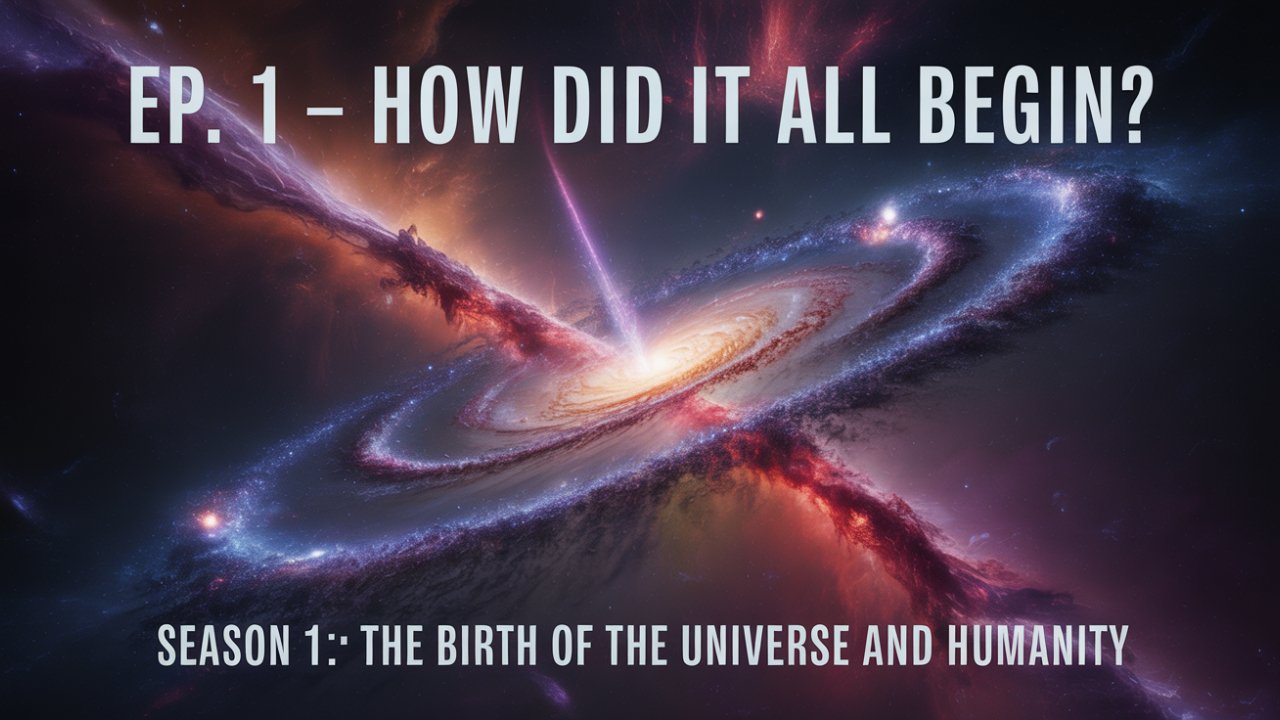Take a look at your hand. The very atoms that make up your bones, the iron flowing through your blood, the carbon in your muscles… they haven’t always been here. They’re ancient travelers on a journey that started 13.8 billion years ago. These particles witnessed the birth of light, the formation of the very first stars, and the slow, cosmic dance of galaxies assembling themselves. So, to understand your own origin story, we have to go back. Not just to the beginning of the Earth, or even our sun… but to the beginning of time and space itself.
And this isn’t just some abstract story about cosmology. This is your story. Every piece of you can be traced back to a single, unimaginable moment. A moment before which there was… well, nothing. No space to measure, no clock to tick, no matter to touch. It’s a concept that truly pushes our language and imagination to their limits. So, how did it all begin? How do you get everything from nothing? This is probably the most profound question we’ve ever asked, and the answer takes us on the most epic journey imaginable the story of our universe.
Before we really get going, we need to try and wrap our heads around the incomprehensible: the state of things before the beginning. When physicists talk about the “nothingness” before the universe, they don’t mean a dark, empty void. An empty void is still a “something” it’s a stage just waiting for actors. The reality is far weirder. According to our best understanding of physics, space and time were born with the Big Bang. That means the very idea of “before” completely breaks down. Without time, there is no before. Without space, there is no where.
It’s a state of absolute non-existence, a realm where the laws of physics as we know them just stop working. Some wild theories speculate about a simmering sea of quantum fluctuations or even a multiverse, where our universe is just one bubble in a cosmic foam. But these ideas are on the bleeding edge of science, with no direct proof. For our story, the journey starts at the boundary of existence and non-existence. It begins at a state of unbelievable density and heat, a condition our physics equations point to called a singularity. This was the seed from which everything we know would grow. A seed planted in no soil, existing in no place, and at no time. From this paradox, the entire cosmos was about to erupt into being.
The Eruption – An Instant of Creation
13.8 billion years ago, it happened. But let’s get one thing straight: the term “Big Bang” is one of the worst names in all of science. It makes you think of a bomb exploding in the middle of an empty room. That’s totally wrong. The Big Bang wasn’t an explosion in space; it was the sudden, rapid expansion of space itself. Everywhere. All at once. Picture a microscopic point, smaller than an atom, containing all the energy the universe would ever have. In a silent flash, this point didn’t explode outward it started to stretch. Space itself began to unfurl, carrying all that energy along with it.
Think of it like blowing up a balloon. Draw two dots on the deflated surface. As you inflate it, the rubber stretches, and the dots move away from each other. They aren’t walking across the balloon; the surface itself is expanding and carrying them along. That’s our universe. Every point in the newborn cosmos rushed away from every other point because the fabric of reality itself was expanding. This was the birth of space, the birth of time, and the start of the physical laws that would run the show for the rest of history.
But the story gets even stranger. In the very first sliver of a second, something incredible happened: a period of hyper-expansion called cosmic inflation. Proposed back in the 80s by physicists like Alan Guth, this theory suggests that right after the Big Bang, the universe blew up at a speed that just breaks your brain. In a fraction of a second so small it’s basically meaningless think 10 to the power of negative 32 seconds the universe doubled in size, then doubled again, and again, at least 80 times over.
To give you some perspective, something the size of a proton would have swelled to become larger than the entire Milky Way galaxy, in less time than it takes light to cross a single atom. This wasn’t just expansion; it was a reality-bending surge that ironed out the fabric of spacetime. Cosmic inflation solves some of the biggest puzzles about our universe, like why it appears so incredibly flat and uniform on the largest scales. It took any initial wrinkles and stretched them into a near-perfectly smooth canvas. And when this insane burst of expansion mysteriously shut off, the energy that drove it was released, transforming into a scorching hot soup of fundamental particles. The Hot Big Bang had officially begun.
The Primordial Soup – Forging the First Matter
As inflation ended, the universe was an unimaginably hot, dense furnace, searing at over ten billion degrees. This wasn’t a universe of stars or galaxies. It was a chaotic, opaque inferno a primordial soup of the most basic particles imaginable. Quarks, electrons, neutrinos, and photons, the particles of light, were constantly being created and destroyed, zipping around in a frantic dance. The universe was so dense that light couldn’t go anywhere without instantly smashing into another particle. It was a perfect, impenetrable fog.
In these first few minutes, as the universe kept expanding, it started to cool. And that cooling changed everything. As the temperature dropped, the fundamental forces of nature began to split off, becoming the distinct forces we know today. The frantic energy of the primordial soup began to settle down, allowing the first stable structures to appear. Quarks, which had been flying free, were now able to team up in threes, forming the very first protons and neutrons the building blocks of every atom.
This led to the first great act of cosmic alchemy: Big Bang Nucleosynthesis. Starting around three minutes after the Big Bang, the universe was finally cool enough for protons and neutrons to fuse together when they collided. The universe cooked up the lightest elements on the periodic table. For every ten protons which are just hydrogen nuclei it fused together one helium nucleus, made of two protons and two neutrons. It also created tiny trace amounts of lithium.
And here’s the beautiful part: the predictions the Big Bang theory makes about these amounts about 75% hydrogen and 25% helium are a stunning success. When astronomers look at the oldest, most pristine gas clouds and stars, the amounts they measure match the theory with incredible accuracy. This is one of the most powerful pieces of evidence that our picture of this early, fiery era is right. In just a few short minutes, the universe had made the raw materials for future stars, planets, and eventually, us. But for now, these atomic nuclei were still swimming in a sea of electrons, trapped in that universe-wide fog. The cosmos was still dark. A pivotal moment was coming, but it would have to wait another 380,000 years.
Section 3: The First Light – The Cosmic Microwave Background
For hundreds of thousands of years, the universe stayed foggy and opaque. Even though hydrogen and helium nuclei had formed, it was still way too hot for them to grab onto electrons and form stable, neutral atoms. The cosmos was a plasma a chaotic mix of positively charged nuclei and negatively charged electrons. And photons, the particles of light, were completely trapped. Every time a photon tried to move, it would immediately slam into a free electron, getting scattered like a pinball. Light was imprisoned. The entire universe was like being trapped inside the thickest fog imaginable.
But the universe kept expanding, and it kept cooling. Then, around 380,000 years after the Big Bang, it crossed a critical threshold. The temperature dropped to about 3,000 degrees Celsius roughly half as hot as the surface of our sun. At this point, it was finally cool enough for the hydrogen and helium nuclei to capture electrons, pulling them into orbit and forming the first complete atoms. This event is called “recombination.”
Suddenly, with all the electrons locked into atoms, the universe became transparent. The cosmic fog lifted. The photons that had been trapped for ages were finally set free. For the first time ever, light could travel unimpeded across the cosmos. This ancient light, released everywhere all at once, is still traveling today. It’s the oldest light in existence, the afterglow of creation.
And we can still see it. We call it the Cosmic Microwave Background, or CMB. As space has expanded over 13.8 billion years, this primordial light has been stretched out, shifting its wavelength from visible light down to the microwave part of the spectrum. When radio telescopes look at the sky, they see this faint, persistent glow coming from every single direction. It’s a baby picture of the universe when it was just 380,000 years old.
Modern telescopes, like the Planck satellite and the Atacama Cosmology Telescope, have mapped the CMB with incredible detail. These maps show a universe that was almost perfectly uniform, but with tiny, minuscule temperature fluctuations variations of just one part in 100,000. These tiny hot and cold spots are everything. They are the seeds of all future structure. The slightly denser, hotter regions had a little more gravity, and over billions of years, that extra pull would gather more and more matter, eventually building the stars, galaxies, and galaxy clusters we see today. The CMB isn’t just an echo of the past; it’s the blueprint for the entire future of the cosmos.
The story of the universe is written across the sky in the language of light and gravity. And with amazing instruments like the James Webb Space Telescope, we’re reading that story more clearly than ever. If you think this journey is as mind-blowing as we do, make sure to subscribe and ring that notification bell. We’re always exploring the latest discoveries from the frontiers of science, from the birth of the cosmos to black holes and distant new worlds. Join our community of curious minds as we keep unraveling the epic story of everything.
The Dark Ages and the Cosmic Dawn
After the universe went clear and the CMB was released, the cosmos entered a long, quiet, and mysterious phase: the Cosmic Dark Ages. For hundreds of millions of years, there were no stars. No galaxies. No new light. The universe was just filled with vast, silent clouds of hydrogen and helium gas, drifting in total darkness. The only light was the fading afterglow of the Big Bang, stretching into ever-longer, less energetic wavelengths. It was a simple, dark, and seemingly boring time.
But under the surface of that darkness, gravity was being very, very patient. Those tiny density variations in the CMB were the seeds of creation. The slightly denser regions began to pull a little harder on the gas around them. Slowly, almost imperceptibly at first, matter started to clump up. The rich got richer as gravity pulled more and more gas into denser and denser knots.
Over millions of years, these clumps grew bigger and more compact. As gravity squeezed them, the pressure and temperature in their cores began to skyrocket. Finally, somewhere between 200 and 400 million years after the Big Bang, the cores of the densest clouds hit a critical temperature of about 10 million degrees Celsius. A new fire was lit in the darkness. Nuclear fusion ignited. The first stars were born.
This was the end of the Cosmic Dark Ages and the beginning of the “Cosmic Dawn.” The universe, dark for so long, was suddenly lit up by these stellar pioneers. These first stars, which astronomers call Population III stars, were unlike anything that exists today. Forged from the pure hydrogen and helium cooked up in the Big Bang, they were thought to be absolute monsters possibly hundreds of times more massive than our sun.
Because they were so huge, they burned incredibly hot and bright, shining with a brilliant blue-white light that bathed the early universe in intense radiation. But they lived fast and died young. A star like our sun lives for ten billion years; these giants burned through their fuel in just a few million. And their deaths were spectacular. They exploded in violent supernovae, blasting something new into the cosmos. For the first time, heavier elements carbon, oxygen, iron, all the stuff needed for life were forged in the hearts of these stars and then hurled out into space. These elements enriched the surrounding gas clouds, paving the way for the next generation of stars. The death of the first stars was the birth of all chemical complexity.
The Rise of Structure – Building the Modern Universe
The explosive deaths of those first stars did more than just cook up heavy elements. They started a chain reaction that would reshape the cosmos. The intense radiation from these giant stars, plus the shockwaves from their supernovae, started to rip electrons off the neutral hydrogen gas that filled space. This process, called “reionization,” essentially cleared the remaining fog over the first billion years, making the universe fully transparent, just as it is today.
Meanwhile, gravity kept doing its thing. The first stars weren’t born alone; they formed inside huge, invisible scaffolds known as dark matter halos. Dark matter, that mysterious stuff that makes up about 85% of all matter, doesn’t interact with light, but its gravity is immense. These halos were the gravitational frameworks where the first galaxies were built. Stars and gas clouds merged and collapsed, forming the first protogalaxies.
And this is where things get really exciting today. The James Webb Space Telescope is giving us an unbelievable new window into this era. Scientists are finding that the early universe was a surprisingly busy place. JWST has spotted galaxies that are shockingly massive and well-formed very early on, some existing just 300 million years after the Big Bang. This is challenging our old models and suggests that galaxy formation may have happened way faster than we thought. We’re seeing “little red dots” that could be the earliest galaxies or even newborn supermassive black holes.
These first galaxies weren’t the majestic spirals we see now. They were smaller, blobby, and chaotic, constantly smashing into each other. Over billions of years, these smaller galaxies collided and merged in a process of “hierarchical assembly,” gradually building up the giant, structured galaxies that decorate our modern universe.
This process also created the biggest thing we know of: the cosmic web. On the largest scales, galaxies aren’t just sprinkled around randomly. They’re arranged in a vast, interconnected network of filaments and clusters, separated by enormous empty voids. This web-like structure is a direct result of those tiny little fluctuations in the baby picture of the universe, blown up by gravity over 13.8 billion years. The intricate cosmos we see today is the result of simple physics acting on the initial conditions set in that very first moment.
We started this journey by looking at our own hand. Now, we can see the full, breathtaking story behind it. The journey of those atoms began 13.8 billion years ago, when time and space erupted from an infinitesimal point. We walked through the fire of the primordial soup where the first bits of matter were forged. We witnessed the moment the universe let there be light, releasing a faint glow we can still see today.
We passed through the Cosmic Dark Ages, where gravity was the lone artist, patiently gathering clouds of gas. Then came the Cosmic Dawn, the lighting of the first monstrous stars. They lived short, brilliant lives, and in their explosive deaths, they created the carbon in our muscles, the oxygen we breathe, and the iron in our blood, scattering it across space. From those ashes, galaxies began to form, merging and growing into the magnificent cosmic web we call home.
The story of the universe is the story of you. You aren’t just living in the universe; you are a living, thinking, conscious piece of it. The same physical laws that guided the expansion, ignited the first stars, and sculpted the galaxies are at work inside you right now. We are literally stardust, brought to life. And with that life comes the incredible privilege of being able to look back, piece this amazing story together, and understand our own place in this vast, beautiful cosmos. The journey from that first silent moment to this one is the greatest story ever told and it’s a story we’re still writing with every new discovery we make.





